JEEP CHEROKEE 2018 Owner handbook (in English)
Manufacturer: JEEP, Model Year: 2018, Model line: CHEROKEE, Model: JEEP CHEROKEE 2018Pages: 312, PDF Size: 4.91 MB
Page 231 of 312
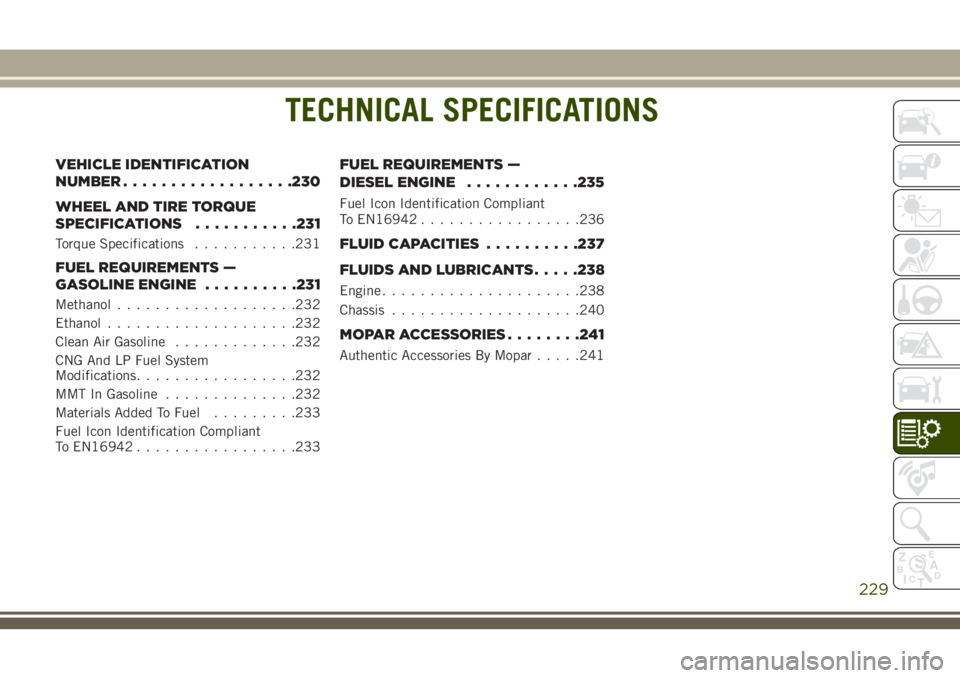
TECHNICAL SPECIFICATIONS
VEHICLE IDENTIFICATION
NUMBER..................230
WHEEL AND TIRE TORQUE
SPECIFICATIONS ...........231
Torque Specifications ...........231
FUEL REQUIREMENTS —
GASOLINE ENGINE ..........231
Methanol...................232
Ethanol ....................232
Clean Air Gasoline .............232
CNG And LP Fuel System
Modifications .................232
MMT In Gasoline ..............232
Materials Added To Fuel .........233
Fuel Icon Identification Compliant
To EN16942 .................233
FUEL REQUIREMENTS —
DIESEL ENGINE ............235
Fuel Icon Identification Compliant
To EN16942.................236
FLUID CAPACITIES ..........237
FLUIDS AND LUBRICANTS .....238
Engine.................... .238
Chassis ....................240
MOPAR ACCESSORIES ........241
Authentic Accessories By Mopar .....241
TECHNICAL SPECIFICATIONS
229
Page 232 of 312
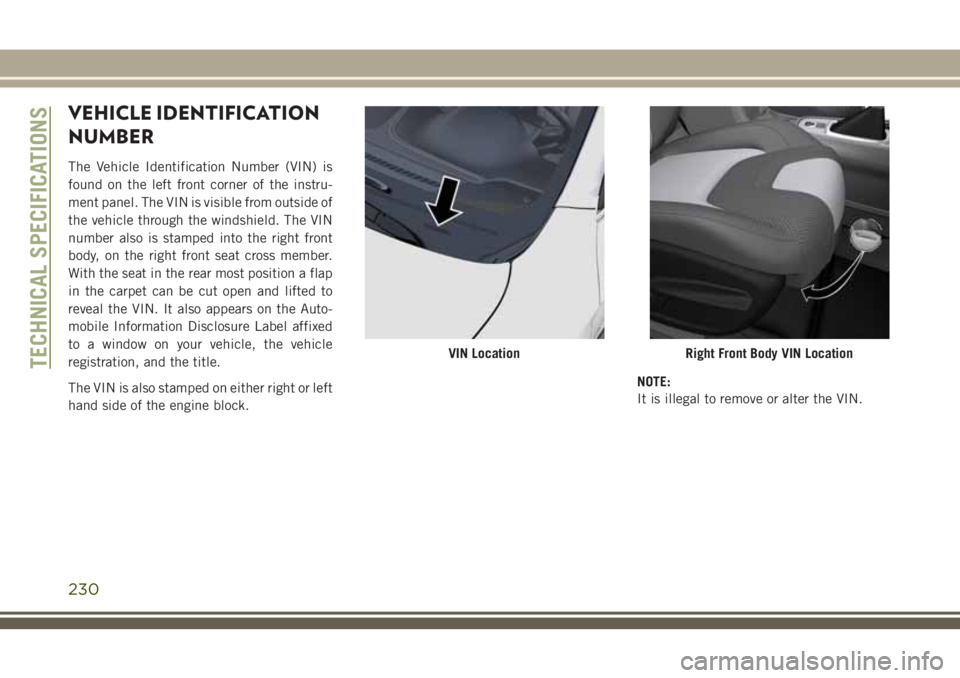
VEHICLE IDENTIFICATION
NUMBER
The Vehicle Identification Number (VIN) is
found on the left front corner of the instru-
ment panel. The VIN is visible from outside of
the vehicle through the windshield. The VIN
number also is stamped into the right front
body, on the right front seat cross member.
With the seat in the rear most position a flap
in the carpet can be cut open and lifted to
reveal the VIN. It also appears on the Auto-
mobile Information Disclosure Label affixed
to a window on your vehicle, the vehicle
registration, and the title.
The VIN is also stamped on either right or left
hand side of the engine block.NOTE:
It is illegal to remove or alter the VIN.
VIN LocationRight Front Body VIN LocationTECHNICAL SPECIFICATIONS
230
Page 233 of 312
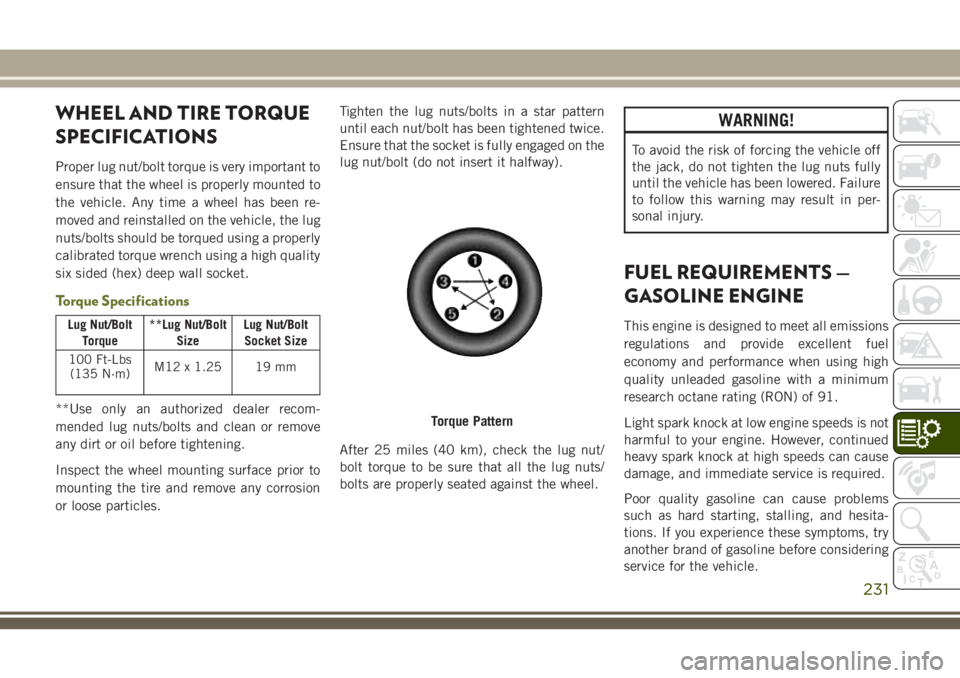
WHEEL AND TIRE TORQUE
SPECIFICATIONS
Proper lug nut/bolt torque is very important to
ensure that the wheel is properly mounted to
the vehicle. Any time a wheel has been re-
moved and reinstalled on the vehicle, the lug
nuts/bolts should be torqued using a properly
calibrated torque wrench using a high quality
six sided (hex) deep wall socket.
Torque Specifications
Lug Nut/BoltTorque **Lug Nut/Bolt
Size Lug Nut/Bolt
Socket Size
100 Ft-Lbs (135 N·m) M12 x 1.25 19 mm
**Use only an authorized dealer recom-
mended lug nuts/bolts and clean or remove
any dirt or oil before tightening.
Inspect the wheel mounting surface prior to
mounting the tire and remove any corrosion
or loose particles. Tighten the lug nuts/bolts in a star pattern
until each nut/bolt has been tightened twice.
Ensure that the socket is fully engaged on the
lug nut/bolt (do not insert it halfway).
After 25 miles (40 km), check the lug nut/
bolt torque to be sure that all the lug nuts/
bolts are properly seated against the wheel.
WARNING!
To avoid the risk of forcing the vehicle off
the jack, do not tighten the lug nuts fully
until the vehicle has been lowered. Failure
to follow this warning may result in per-
sonal injury.
FUEL REQUIREMENTS —
GASOLINE ENGINE
This engine is designed to meet all emissions
regulations and provide excellent fuel
economy and performance when using high
quality unleaded gasoline with a minimum
research octane rating (RON) of 91.
Light spark knock at low engine speeds is not
harmful to your engine. However, continued
heavy spark knock at high speeds can cause
damage, and immediate service is required.
Poor quality gasoline can cause problems
such as hard starting, stalling, and hesita-
tions. If you experience these symptoms, try
another brand of gasoline before considering
service for the vehicle.
Torque Pattern
231
Page 234 of 312
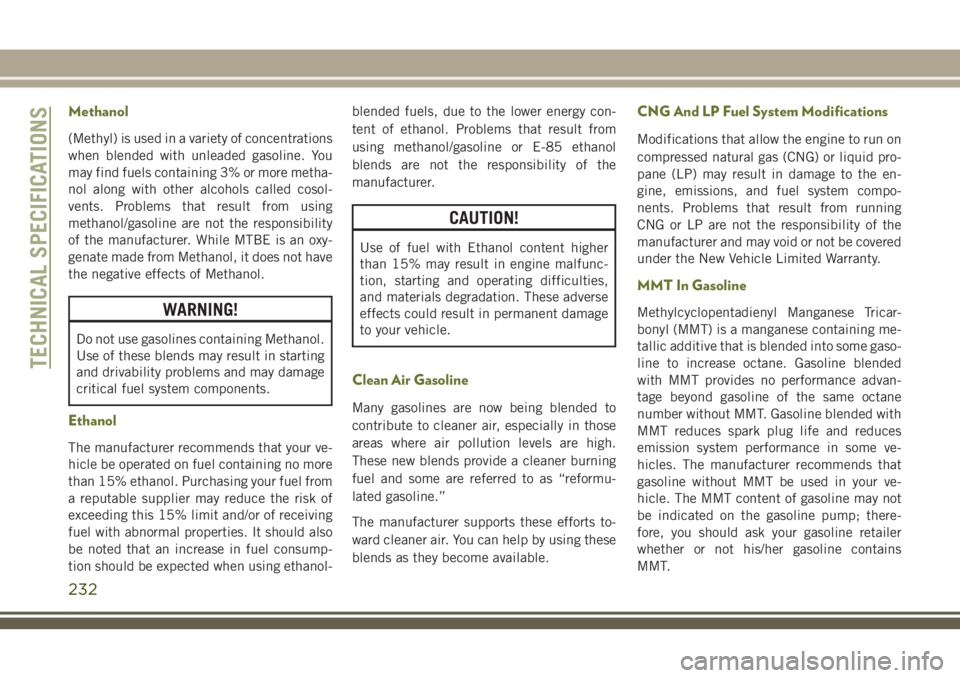
Methanol
(Methyl) is used in a variety of concentrations
when blended with unleaded gasoline. You
may find fuels containing 3% or more metha-
nol along with other alcohols called cosol-
vents. Problems that result from using
methanol/gasoline are not the responsibility
of the manufacturer. While MTBE is an oxy-
genate made from Methanol, it does not have
the negative effects of Methanol.
WARNING!
Do not use gasolines containing Methanol.
Use of these blends may result in starting
and drivability problems and may damage
critical fuel system components.
Ethanol
The manufacturer recommends that your ve-
hicle be operated on fuel containing no more
than 15% ethanol. Purchasing your fuel from
a reputable supplier may reduce the risk of
exceeding this 15% limit and/or of receiving
fuel with abnormal properties. It should also
be noted that an increase in fuel consump-
tion should be expected when using ethanol-blended fuels, due to the lower energy con-
tent of ethanol. Problems that result from
using methanol/gasoline or E-85 ethanol
blends are not the responsibility of the
manufacturer.
CAUTION!
Use of fuel with Ethanol content higher
than 15% may result in engine malfunc-
tion, starting and operating difficulties,
and materials degradation. These adverse
effects could result in permanent damage
to your vehicle.
Clean Air Gasoline
Many gasolines are now being blended to
contribute to cleaner air, especially in those
areas where air pollution levels are high.
These new blends provide a cleaner burning
fuel and some are referred to as “reformu-
lated gasoline.”
The manufacturer supports these efforts to-
ward cleaner air. You can help by using these
blends as they become available.
CNG And LP Fuel System Modifications
Modifications that allow the engine to run on
compressed natural gas (CNG) or liquid pro-
pane (LP) may result in damage to the en-
gine, emissions, and fuel system compo-
nents. Problems that result from running
CNG or LP are not the responsibility of the
manufacturer and may void or not be covered
under the New Vehicle Limited Warranty.
MMT In Gasoline
Methylcyclopentadienyl Manganese Tricar-
bonyl (MMT) is a manganese containing me-
tallic additive that is blended into some gaso-
line to increase octane. Gasoline blended
with MMT provides no performance advan-
tage beyond gasoline of the same octane
number without MMT. Gasoline blended with
MMT reduces spark plug life and reduces
emission system performance in some ve-
hicles. The manufacturer recommends that
gasoline without MMT be used in your ve-
hicle. The MMT content of gasoline may not
be indicated on the gasoline pump; there-
fore, you should ask your gasoline retailer
whether or not his/her gasoline contains
MMT.
TECHNICAL SPECIFICATIONS
232
Page 235 of 312
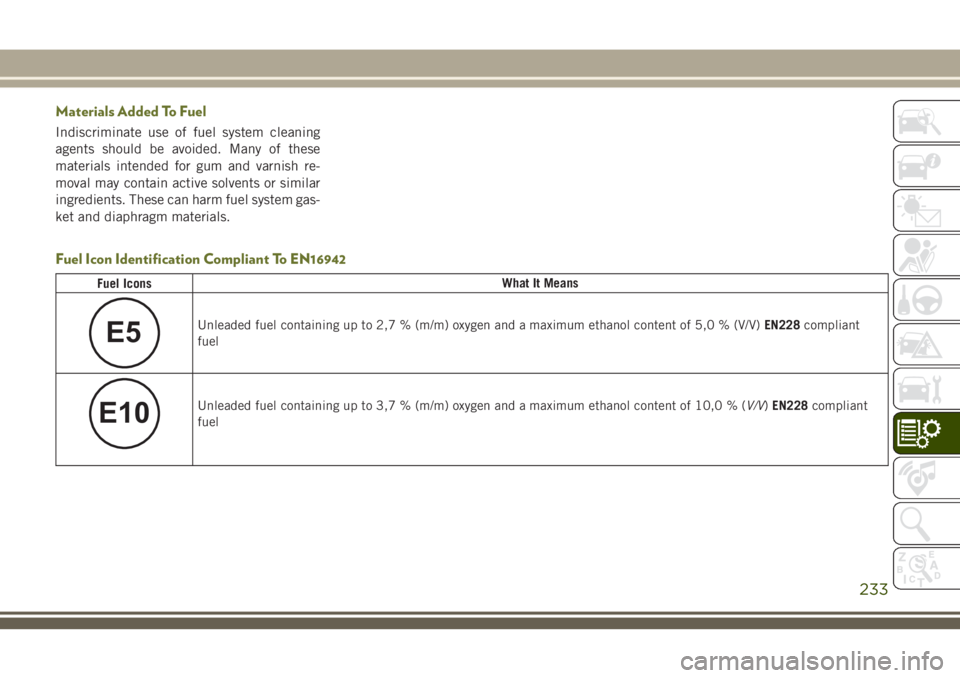
Materials Added To Fuel
Indiscriminate use of fuel system cleaning
agents should be avoided. Many of these
materials intended for gum and varnish re-
moval may contain active solvents or similar
ingredients. These can harm fuel system gas-
ket and diaphragm materials.
Fuel Icon Identification Compliant To EN16942
Fuel IconsWhat It Means
E5Unleaded fuel containing up to 2,7 % (m/m) oxygen and a maximum ethanol content of 5,0 % (V/V)
EN228compliant
fuel
E10Unleaded fuel containing up to 3,7 % (m/m) oxygen and a maximum ethanol content of 10,0 % (V/V) EN228compliant
fuel
233
Page 236 of 312
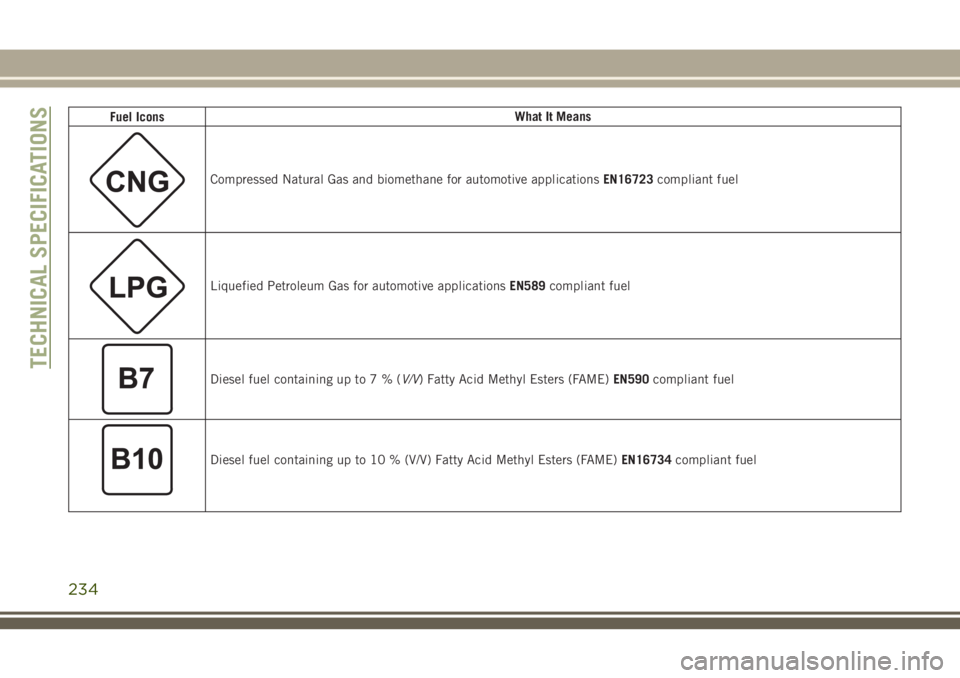
Fuel IconsWhat It Means
Compressed Natural Gas and biomethane for automotive applications
EN16723compliant fuel
Liquefied Petroleum Gas for automotive applications EN589compliant fuel
Diesel fuel containing up to7%( V/V) Fatty Acid Methyl Esters (FAME) EN590compliant fuel
Diesel fuel containing up to 10 % (V/V) Fatty Acid Methyl Esters (FAME) EN16734compliant fuel
TECHNICAL SPECIFICATIONS
234
Page 237 of 312
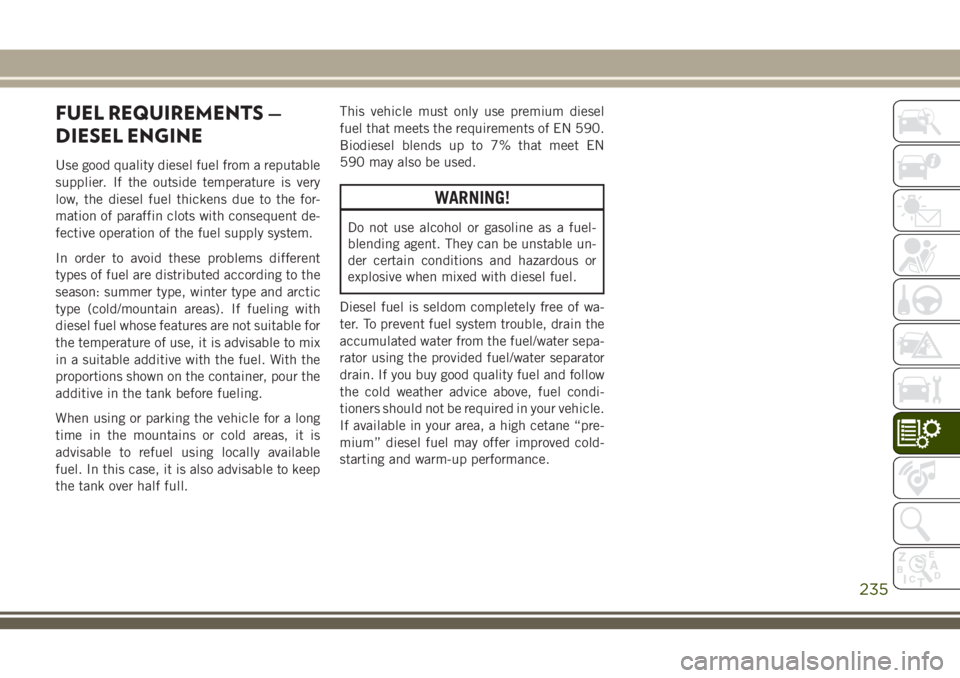
FUEL REQUIREMENTS —
DIESEL ENGINE
Use good quality diesel fuel from a reputable
supplier. If the outside temperature is very
low, the diesel fuel thickens due to the for-
mation of paraffin clots with consequent de-
fective operation of the fuel supply system.
In order to avoid these problems different
types of fuel are distributed according to the
season: summer type, winter type and arctic
type (cold/mountain areas). If fueling with
diesel fuel whose features are not suitable for
the temperature of use, it is advisable to mix
in a suitable additive with the fuel. With the
proportions shown on the container, pour the
additive in the tank before fueling.
When using or parking the vehicle for a long
time in the mountains or cold areas, it is
advisable to refuel using locally available
fuel. In this case, it is also advisable to keep
the tank over half full.This vehicle must only use premium diesel
fuel that meets the requirements of EN 590.
Biodiesel blends up to 7% that meet EN
590 may also be used.
WARNING!
Do not use alcohol or gasoline as a fuel-
blending agent. They can be unstable un-
der certain conditions and hazardous or
explosive when mixed with diesel fuel.
Diesel fuel is seldom completely free of wa-
ter. To prevent fuel system trouble, drain the
accumulated water from the fuel/water sepa-
rator using the provided fuel/water separator
drain. If you buy good quality fuel and follow
the cold weather advice above, fuel condi-
tioners should not be required in your vehicle.
If available in your area, a high cetane “pre-
mium” diesel fuel may offer improved cold-
starting and warm-up performance.
235
Page 238 of 312
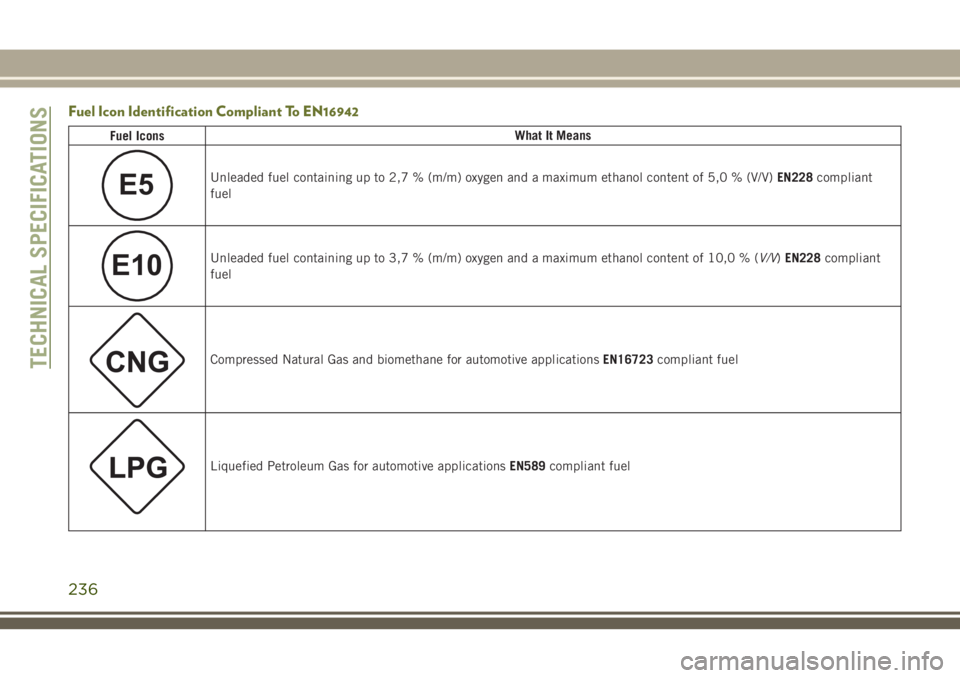
Fuel Icon Identification Compliant To EN16942
Fuel IconsWhat It Means
E5Unleaded fuel containing up to 2,7 % (m/m) oxygen and a maximum ethanol content of 5,0 % (V/V)
EN228compliant
fuel
E10Unleaded fuel containing up to 3,7 % (m/m) oxygen and a maximum ethanol content of 10,0 % (V/V) EN228compliant
fuel
Compressed Natural Gas and biomethane for automotive applications EN16723compliant fuel
Liquefied Petroleum Gas for automotive applications EN589compliant fuel
TECHNICAL SPECIFICATIONS
236
Page 239 of 312
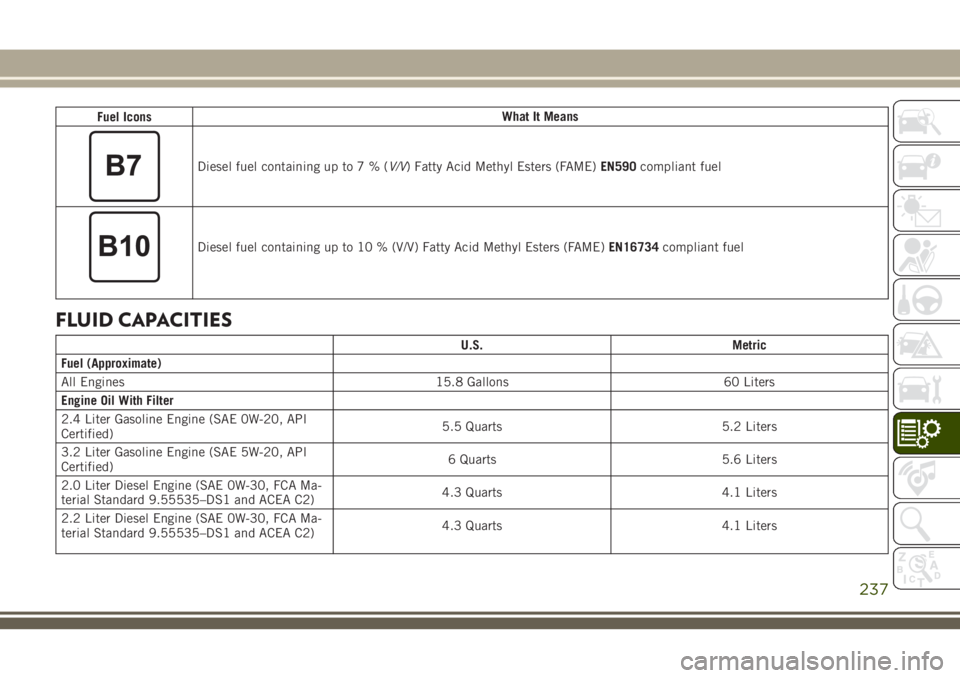
Fuel IconsWhat It Means
Diesel fuel containing up to7%(
V/V) Fatty Acid Methyl Esters (FAME) EN590compliant fuel
Diesel fuel containing up to 10 % (V/V) Fatty Acid Methyl Esters (FAME) EN16734compliant fuel
FLUID CAPACITIES
U.S. Metric
Fuel (Approximate)
All Engines 15.8 Gallons60 Liters
Engine Oil With Filter
2.4 Liter Gasoline Engine (SAE 0W-20, API
Certified) 5.5 Quarts
5.2 Liters
3.2 Liter Gasoline Engine (SAE 5W-20, API
Certified) 6 Quarts
5.6 Liters
2.0 Liter Diesel Engine (SAE 0W-30, FCA Ma-
terial Standard 9.55535–DS1 and ACEA C2) 4.3 Quarts
4.1 Liters
2.2 Liter Diesel Engine (SAE 0W-30, FCA Ma-
terial Standard 9.55535–DS1 and ACEA C2) 4.3 Quarts
4.1 Liters
237
Page 240 of 312

U.S.Metric
Cooling System*
2.4 Liter Gasoline Engine (PARAFLU
UP) 7.2 Quarts 6.8 Liters
3.2 Liter Gasoline Engine (PARAFLUUP) 10 Quarts 9.5 Liters
2.0 Liter Diesel Engine (PARAFLUUP) 7.2 Quarts 6.8 Liters
2.2 Liter Diesel Engine (PARAFLUUP) 7.2 Quarts 6.8 Liters
* Includes heater and coolant recovery bottle filled to MAX level.
FLUIDS AND LUBRICANTS
Engine
Component Fluid, Lubricant, or Genuine Part
Engine Coolant We recommend you use PARAFLUUPFormula OAT (Organic Additive
Technology) or equivalent meeting the requirements of FCA Material
Standard MS.90032.
Engine Oil – (2.4L Engine) We recommend you use SAE 0W-20 API Certified Engine Oil, meeting the requirements of FCA Material Standard MS-6395. Refer to your engine oil
filler cap for correct SAE grade.
Engine Oil – (3.2L Engine) We recommend you use SAE 5W-20 API Certified Engine Oil, meeting the requirements of FCA Material Standard MS-6395. Refer to your engine oil
filler cap for correct SAE grade.
SAE 5W-30 engine oil approved to MS-6395 may be used when SAE
5W-20 engine oil is not available.
TECHNICAL SPECIFICATIONS
238